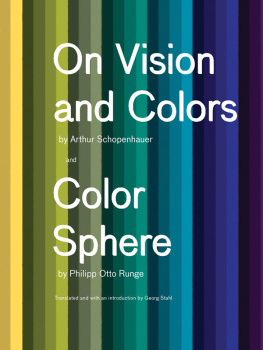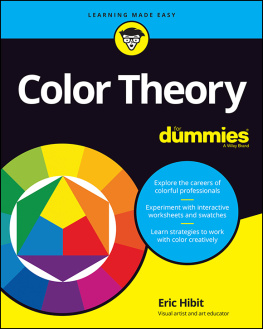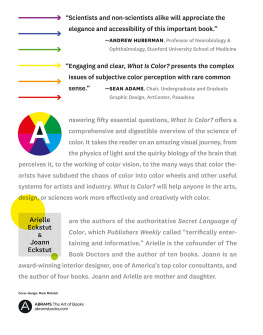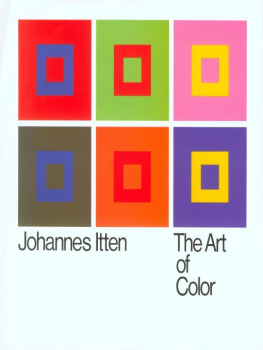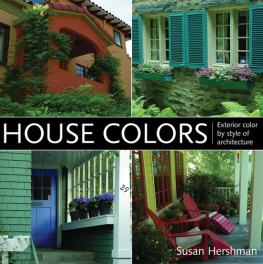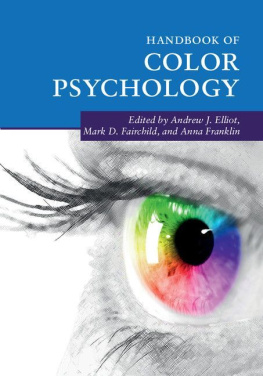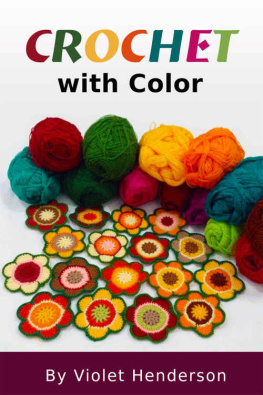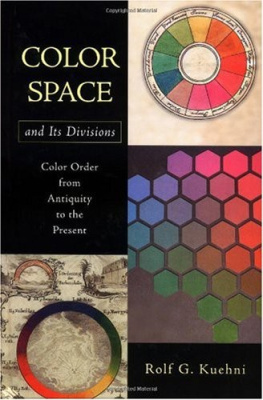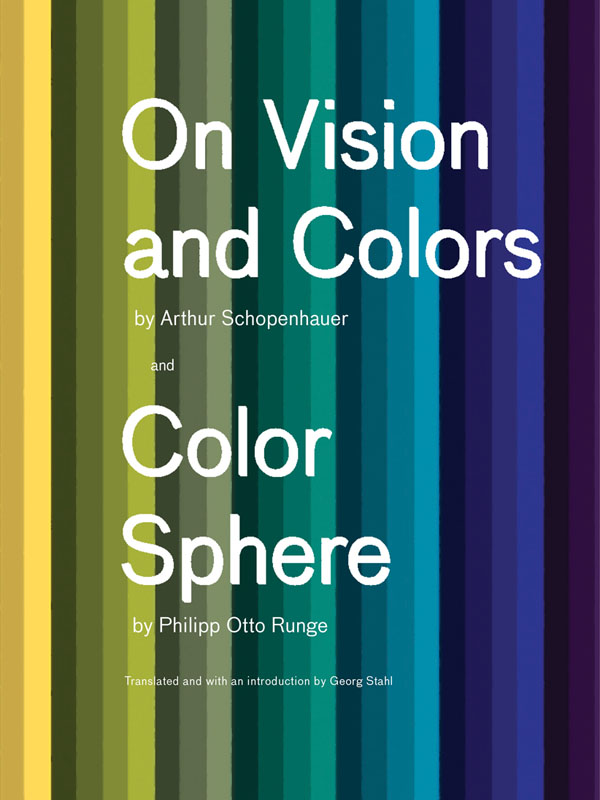

On Vision and Colors
BY ARTHUR SCHOPENHAUER
and
Color Sphere
BY PHILIPP OTTO RUNGE

On Vision
and Colors
by Arthur Schopenhauer
and
Color Sphere
by Philipp Otto Runge
Translated and with an introduction by Georg Stahl

Princeton Architectural Press New York
Published by
Princeton Architectural Press
37 East Seventh Street
New York, New York 10003
For a free catalog of books, call 1.800.722.6657.
Visit our web site at www.papress.com.
2010 Princeton Architectural Press
All rights reserved
Printed and bound in China
13 12 11 10 4 3 2 1 First edition
No part of this book may be used or reproduced in any manner without written permission from the publisher, except in the context of reviews.
Every reasonable attempt has been made to identify owners of copyright. Errors or omissions will be corrected in subsequent editions.
Editor: Linda Lee
Designer print edition: Deb Wood
Special thanks to: Nettie Aljian, Bree Anne Apperley, Sara Bader, Nicola Bednarek, Janet Behning, Becca Casbon, Carina Cha, Thomas Cho, Penny (Yuen Pik) Chu, Carolyn Deuschle, Russell Fernandez, Pete Fitzpatrick, Wendy Fuller, Jan Haux, Clare Jacobson, Erin Kim, Nancy Eklund Later, Laurie Manfra, John Myers, Katharine Myers, Dan Simon, Andrew Stepanian, Jennifer Thompson, Paul Wagner, and Joseph Weston of Princeton Architectural Press
Kevin C. Lippert, publisher
Library of Congress Cataloging-in-Publication Data
Schopenhauer, Arthur, 17881860.
[Ueber das Sehn und die Farben. English]
On vision and colors / by Arthur Schopenhauer. And, Color sphere / by Philipp Otto Runge ; translated and with an introduction by Georg Stahl. 1st ed.
p. cm.
Includes bibliographical references (p. ) and index.
ISBN 978-1-56898-791-0 (alk. paper)
ISBN 978-1-61689-005-6 (digital)
1. Color. 2. Vision. I. Stahl, Georg, 1937 II. Runge, Philipp Otto, 17771810. Farbenkugel. English. III. Title. IV. Title: Color sphere.
QC495.S3313 2009
701.85dc22
2009015790

In memory of my parents

PREFACE

The purpose of this translation of Arthur Schopenhauers color theory ber das Sehn und die Farben (On Vision and Colors) and Philipp Otto Runges Farbenkugel (Color Sphere) is to bring the subject matter of these two theories to as wide an audience as possible, interested in color in the broadest sense: in its expressions and applications within the context of philosophy, art theory, aesthetics, art, and architecture.
Schopenhauer as a philosopher, however, is not much read today, and his philosophy never attracted large audiences historically; he has always been the philosopher of a small congregation. Therefore, the idea of a translation of his color theory as an isolated text did not seem to be an attractive format. Although Schopenhauer did not consider this essay a part of his philosophical system, the subject continued to be of much interest to him. A revised version in Latin was published in 1830; in 1847 the first chapter, On Vision, appeared reworked and expanded as Section 21 in the second edition of Schopenhauers ber die vierfache Wurzel des Satzes vom zureichenden Grunde (On the Fourfold Root of the Principle of Sufficient Reason) . He includes in the second volume of his Parerga and Paralipomena , published in 1851, an addition to his color theory under the same title as Goethes famous color theory, Zur Farbenlehre (Color Theory) . In 1854 a second edition of On Vision and Colors was published. As a color theory it never gained much attention in the color community, and was forgotten soon after its publication. To make the text more relevant for a modern reader, a different publication format had to be contemplated.
The solution resided in Schopenhauers essay itself. In the second chapter, Schopenhauer refers to the theory and color sphere of Philipp Otto Runge, and, assuming that his readers are familiar with Runges color theory, gives a brief description of its appearance: a symmetrical sphere of which the equator is made up of a chromatic color circle, fading toward a white pole and darkening toward a black achromatic pole. Schopenhauer demonstrates how the colors as they appear on Runges color sphere can be explained with his theory of the divisibility of the activity of the retina.
References to Runges Color Sphere in art and color-related literature are sparse, and up to now Runges color theory has been little known in the English-speaking world, for no English translation has been available. Given these facts, a unique possibility presented itself to publish both Schopenhauers and Runges color theories in one volume. In addition, a relationship existed between Goethes Color Theory , a magnum opus amongst color theories, and Schopenhauers On Vision and Colors. Schopenhauer would not have written his color theory were it not for Goethe introducing him personally to his theory. Likewise, Runge, during the development of his color circle and color sphere, was in regular contact with Goethe.
Color Sphere , Runges main theoretical work, although entirely different from Schopenhauers color theory, encountered a fate similar to Schopenhauers essay. Runge died in 1810, the year the booklet was published, and the limited, hand-colored edition soon became very hard to come by. It was not until 1924 that it was republished, by Wilhelm Ostwald. Although Runges theory has been hailed as ahead of its time, at the time the color system was too modern to be recognized as the artists tool the author had intended it to be. Runges color theory, as well as his work, was also soon forgotten.
It became evident while preparing the translation of Color Sphere that Runge had omitted one specific category of colors: transparent colors. They make up an important segment of Runges theoretical writings about color as a whole, and the subject appears repeatedly throughout his writings. He discusses the topic in depth in a separate essay, Von der Doppelheit der Farbe (About the Duality of Color). Any publication of Runges color theory would not be complete without this essay.
One question remained: Was there a contemporary context in which both Schopenhauers and Runges color theories could be understood? Surprisingly there was. Shortly before and during the early 1920s, a member of the Dutch De Stijl group became interested in Schopenhauers color theory. It was the architect Gerrit Rietveld who maintained a lifelong interest not only in Schopenhauers color theory, but also in his philosophy in general. This can be traced through his handwritten notes, publications, and lectures, and is expressed most visibly in his early polychrome furniture and architecture. Likewise, it is documented that Paul Klee, the Swiss-born German painter, was influenced by Runges Color Sphere from 1920 on, which is reflected above all in his lecture notes for the color course that he taught at the Bauhaus.

